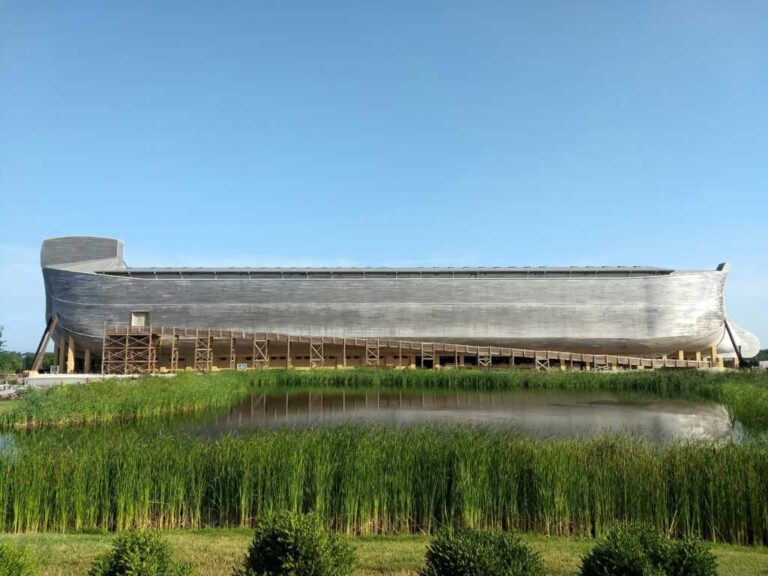An independent researcher who spent time exploring the location near Mount Ararat, where the ruins of Noah’s Ark are believed to be speaking out.
Listen to the latest episodes of “Quick Start”
Andrew Jones, who runs Noah’s Ark Scan, is a group that described it as “a loose organization of individuals interested in pursuing scientific work and promotions (Boxark’s site), and said he became interested in Genesis’s Flood Stories as a child.
A few years later, at university, the plot expanded when he visited Türkiye and saw his place.
“I’ve been coming and going ever since,” he said.
Jones said Noah’s Arkscan worked with scientists to explore the Mount Ararat site and take steps to identify whether it was truly a resting place for a huge Bible ship.
“Last year, this (time) we had an Australian soil scientist coming out there, and he proposed a soil test because he noticed that the grass growing in this boat formation is a different colour from just outside the boat’s object,” he said. “So (he) and the local Turkish geologist designed the test, they got the samples, and we got some… we got some really interesting results.”
One of the central questions surrounding the ARK site is why it took so long to conduct identifiable and conclusive research if it is thought to potentially retain these artefacts.
Jones said a series of issues support the process.
“We are just as interested as anyone else in proofing or disproving what this site is,” he said. “There are a lot of factors involved. This is East Turkey, partly because it is politics. There are issues that can affect scientific work. Then there are issues that are religious.”
From Christian claims to Islamic claims, there is a “competition” that surrounds the story. Mixing it with other factors, among other factors, has created a barrier.
“If you are pursuing scientific research on this site, you must work with your local university. This means you will need to find a university or professor who will put your career on the line, looking for Noah’s Ark, which can be a problem for Islamic scholars as well,” Jones said. “People think you’re into something like this. So, yeah, that’s very difficult.”
But Jones said he and others continue to push, working with local governments and international partners to analyze and explore areas they believe the ship may be located.
As for location, Jones said the Bible gives “a very simple explanation” in Genesis. In fact, Genesis 8:4 reads (NIV) (NIV).
According to Jones, Moses’ description is not GPS-specific.
“It’s like I say today, ‘Noalk landed in the mountains of Colorado and the mountains of Canada,” he said. “That’s a general area.”
The site Jones and others are exploring is in the area, he said. The site’s shape reportedly attracted the attention of Turkish military officials decades ago.
“They frown and sway the far corner of Turkey, a unique geological layer excavated by Turkish Army captain Ilhan Durpinner on September 11, 1959, bringing brows to interest from biblical scholars and geologists.” “This boat-shaped geological curiosity, commonly known as the Durpinner Formation, is considered to be the final resting place in Noah’s Ark.”
At the time, the discovery created a media splash, and people quickly began to go out to see for themselves. But ultimately, Jones said the place was mostly “forgotten” until an American named Ronald Wyatt began exploring and promoting it before his death in the 1980s and 1990s.
Jones and others have since worked with experts to pick up the mantle and collect evidence. He described certain components that some believe this is a good candidate for the Ark location.
“It’s number one, there’s a boat shape,” Jones said. He also said that the sizes of the Bible are lined up. “We have shapes, we have matching locations, and we have lengths that match the Bible exactly.”
He continued. “The only tests we can do now are non-destructive tests, like geophysical scans. …GPR uses underground penetration radar, ERT, electricity to measure resistant properties (those under the ground).”
This data is used to create models and explore what could be inside the soil. So far, he and other researchers believe there is a “angular structure” underground and a “central tunnel” within the structure.
Ultimately, they hope to excavate when conditions and parameters are allowed. It is important to use non-destructive measures at the moment. Jones wants to continue collecting samples and plan to better identify what’s under the area.
“We hope that before the drilling is thought to be able to code sites at random locations, we show that the radar looks like a (natural) angular structure. “And some of these voids, this tunnel is down the middle about four meters below.”
These samples provide more information and context to help you better understand what’s going on within the site, Jones said. He also hopes to do more soil testing.
Ultimately, he believes this is based on the size, shape and data that “must be a ruin” of Noah’s Ark. He doesn’t expect it to be completely preserved due to age and time, but he sees the site as “best candidate” at this time of year.
If you’re interested, you can follow Noah’s Ark Scanning Journey here.
As the number of voices facing big technology censorship continues to grow, sign up for Faithwire’s daily newsletter and download the CBN news app developed by the parent company to keep you up to date with the latest news from a clear Christian perspective.
